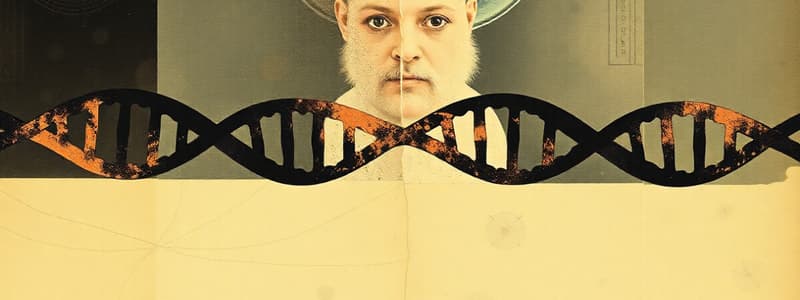Podcast
Questions and Answers
What role do restriction endonucleases play in DNA cloning?
What role do restriction endonucleases play in DNA cloning?
- They modify nucleotide sequences.
- They amplify DNA through PCR.
- They replicate the DNA sequences.
- They cut foreign DNA at specific sequences. (correct)
Which type of restriction enzyme is primarily used in DNA manipulation due to its precision?
Which type of restriction enzyme is primarily used in DNA manipulation due to its precision?
- Type III
- Type I
- Type II (correct)
- Type IV
What is the primary function of DNA ligase in the cloning process?
What is the primary function of DNA ligase in the cloning process?
- To replicate the entire DNA strand.
- To cut DNA fragments into smaller pieces.
- To join two DNA fragments into a stable molecule. (correct)
- To create sticky ends on DNA fragments.
Which of the following is an example of a cloning vector used in DNA cloning?
Which of the following is an example of a cloning vector used in DNA cloning?
In cell-based DNA cloning, what is introduced into the bacterial cell?
In cell-based DNA cloning, what is introduced into the bacterial cell?
What is the primary function of plasmids in genetic engineering?
What is the primary function of plasmids in genetic engineering?
What role do antibiotic resistance genes play in plasmids?
What role do antibiotic resistance genes play in plasmids?
How do bacteria incorporate foreign DNA during transformation?
How do bacteria incorporate foreign DNA during transformation?
What is a common method for screening bacteria that have taken up recombinant plasmids?
What is a common method for screening bacteria that have taken up recombinant plasmids?
What characteristic of bacterial DNA makes it easier to manipulate in genetic engineering?
What characteristic of bacterial DNA makes it easier to manipulate in genetic engineering?
What is the approximate size of a typical bacterial genome compared to a eukaryotic genome?
What is the approximate size of a typical bacterial genome compared to a eukaryotic genome?
During which phase do bacterial cells reproduce through binary fission?
During which phase do bacterial cells reproduce through binary fission?
What is the typical structure of plasmids used in genetic engineering?
What is the typical structure of plasmids used in genetic engineering?
What is the primary function of restriction enzymes in gene cloning?
What is the primary function of restriction enzymes in gene cloning?
What characteristic do sticky ends produced by restriction enzymes possess?
What characteristic do sticky ends produced by restriction enzymes possess?
How do bacteria protect their own DNA from being cut by restriction enzymes?
How do bacteria protect their own DNA from being cut by restriction enzymes?
In gene cloning, what role does DNA ligase play?
In gene cloning, what role does DNA ligase play?
Why might a scientist clone a gene rather than an entire organism?
Why might a scientist clone a gene rather than an entire organism?
What process involves inserting recombinant plasmids into bacteria?
What process involves inserting recombinant plasmids into bacteria?
What does gene cloning achieve regarding proteins?
What does gene cloning achieve regarding proteins?
How does the action of restriction enzymes relate to the cloning metaphor of 'cut, paste, and copy'?
How does the action of restriction enzymes relate to the cloning metaphor of 'cut, paste, and copy'?
Flashcards are hidden until you start studying
Study Notes
DNA Cloning
- A particular gene can be isolated and sequenced
- DNA sequences can be identified and analyzed
- Protein, enzyme, and RNA functions can be investigated
- Mutations, like those related to disease, can be identified
- Organisms can be engineered for specific purposes, like insulin production or insect resistance
Cell-Based DNA Cloning
- Recombinant plasmid DNA is introduced into a bacterial cell
Restriction Endonucleases
- Enzymes found in hosts that cut up foreign DNA, like viral DNA
- Cut within the foreign DNA, rather than chewing from the ends
- Recognize a specific 4-12bp DNA sequence and cut both strands
Three Types of Restriction Enzymes
- Type I and III cleave DNA with less precision and are not used in manipulating DNA
- Type II recognize specific DNA sequences and cleave at specific sites within the sequence. This can lead to "sticky ends" that can be joined.
DNA Ligase
- Covalently links two DNA strands
- Catalyzes the formation of a phosphodiester bond between adjacent phosphate and hydroxyl groups of DNA nucleotides
Cloning Vectors
- Plasmids (e.g. pBR 322, pUC 19)
- Phages/Bacteriophages (viruses that infect bacteria, e.g. lambda phage)
- Artificial chromosome vectors (e.g. YACs, BACs)
- Phagemids (combine features of phages and plasmids)
Restriction Enzymes
- Discovered in the 1960s
- Evolved in bacteria to cut up foreign DNA
- Bacteria protect their own DNA by methylation and by not using the base sequences recognized by the enzymes in their own DNA
- Cut DNA at specific sequences (restriction sites).
- Often symmetrical
- Produce protruding ends ("sticky ends") that bind to any complementary DNA
Sticky Ends
- Help glue genes together
- Cut other DNA with the same enzyme
- Can glue DNA together at "sticky ends"
Why Mix Genes Together?
- To produce a protein in a different organism or individual
Copy (& Read) DNA
- Transformation: Inserting a recombinant plasmid into bacteria
- Grow recombinant bacteria in agar cultures: bacteria make lots of copies of the plasmid ("cloning")
- Produce many copies of the inserted gene
- Production of "new" protein
- DNA → RNA → protein → trait
Cut, Paste, Copy
- Restriction Enzymes: "Cut"
- Ligase: "Paste"
- Plasmids: "Copy"
Gene Cloning
- Cloning: A method of growing an individual from a single somatic cell of its parent
- Clone: A collection of genetically identical molecules or cells.
What is DNA/gene cloning?
- When DNA is extracted from an organism, all its genes are obtained
- In gene cloning, a particular gene is copied (cloned)
Why Clone DNA?
- Genetic Engineering
Human Genome
- 3.2 billion bases
Biotechnology Today
- Genetic Engineering: Manipulation of DNA
- Tools are needed to work with DNA, genes, and organisms
Bacteria
- One-celled prokaryotes
- Reproduce by binary fission
- Rapid growth (generation every ~20 minutes)
- Dominant form of life on earth
- Incredibly diverse
Bacterial Genome
- Single, circular chromosome
- Haploid
- Naked DNA (no histone proteins)
- ~4 million base pairs
- ~4300 genes
- 1/1000 of the amount of DNA in a eukaryote
Transformation
- Bacteria pick up naked foreign DNA by importing bits of chromosomes from other bacteria
- Incorporate the DNA bits into their own chromosome
Plasmids
- Small, extrachromosomal circular DNA (5000-20,000 base pairs)
- Self-replicating
- Carry extra genes (2-30 genes)
- Can be exchanged between bacteria
How Can Plasmids Help Us?
- Insert a new gene into a plasmid
- Insert the plasmid into bacteria ("vector")
- Bacteria now express the new gene and make a new protein
Biotechnology
- Plasmids are used to insert new genes into bacteria
Engineered Plasmids
- Building custom plasmids with:
- Restriction enzyme sites
- Antibiotic resistance genes as selectable markers
Selectable Marker
- Antibiotic resistance gene on the plasmid (e.g., ampicillin resistance)
- Used to select for successful transformation (successful uptake of the recombinant plasmid)
Selection for Plasmid Uptake
- Antibiotic acts as a selecting agent
- Only bacteria with the plasmid will grow on an antibiotic (ampicillin) plate
Screening for Recombinant Plasmid
- Bacteria successfully take up the plasmid:
- Functional LacZ gene
- Bacteria make blue color
- Bacteria take up the recombinant plasmid:
- Non-functional LacZ gene
- Bacteria stay white
How Do We Cut DNA?
- Restriction Endonucleases
Studying That Suits You
Use AI to generate personalized quizzes and flashcards to suit your learning preferences.




